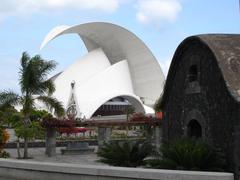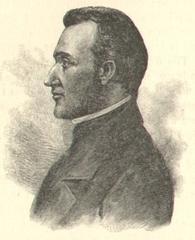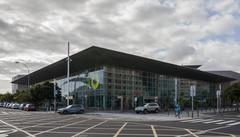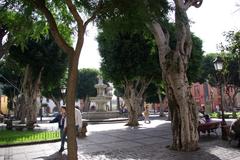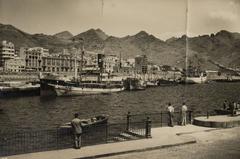A Complete Guide to Visiting A Crosita in Santa Cruz de Tenerife, Spain: Tickets, Hours, and Top Attractions
Date: 14/06/2025
Introduction to A Crosita and What Visitors Can Expect
Nestled in the vibrant city of Santa Cruz de Tenerife on the northeastern coast of Tenerife Island, A Crosita stands as a remarkable cultural and historical destination. Deeply rooted in the indigenous Guanche civilization and shaped by centuries of Spanish influence, A Crosita offers visitors an immersive encounter with the rich heritage of the Canary Islands. Its blend of preserved colonial architecture, significant religious monuments, and thriving urban life paints a vivid picture of Santa Cruz’s dynamic past and present.
At A Crosita, visitors encounter not only historic landmarks like the Iglesia de la Concepción but also a lively cultural scene with public art, world-renowned festivals such as Carnival, and a host of museums celebrating the island’s natural and artistic legacy. The city’s strategic port location has cultivated a multicultural atmosphere, reflected in its diverse culinary offerings and cosmopolitan urban fabric.
This guide provides essential details—including visiting hours, ticketing, accessibility, and practical tips—for A Crosita and nearby attractions. Whether you are drawn to the archaeological wonders of the Guanche people, architectural gems like the Auditorio de Tenerife, or green havens like García Sanabria Park, this resource will help you plan an unforgettable journey to one of Spain’s most enchanting Canary Islands destinations.
For up-to-date event information and cultural insights, consult resources such as the Auditorio de Tenerife website and tenerifecanaryislands.com. Prepare to immerse yourself in a destination where history, culture, and natural beauty converge seamlessly.
Table of Contents
- The Historical Evolution of A Crosita and Santa Cruz de Tenerife
- Cultural Significance and Must-See Institutions
- Socio-Economic and Environmental Context
- Practical Visitor Information
- Top Attractions and Suggested Itinerary
- Essential Tips and FAQs
- Conclusion and Resources
The Historical Evolution of A Crosita and Santa Cruz de Tenerife
Guanche Origins and Pre-Colonial Heritage
Before European conquest, the area now known as Santa Cruz de Tenerife—including A Crosita—belonged to the indigenous Guanche people as part of the Menceyato de Anaga. Archaeological discoveries, including the Mummy of San Andrés and ancient petroglyphs, provide crucial insight into the spiritual and social life of the Guanches (tenerifecanaryislands.com).
Spanish Conquest and Colonial Development
The Spanish foundation of Santa Cruz de Tenerife in 1494 marked the beginning of a new era. The city’s name—“Holy Cross of Tenerife”—commemorates the planting of a Christian cross that symbolized Castilian rule (Wikipedia). From a small port, Santa Cruz quickly evolved into a key trading hub linking Europe, Africa, and the Americas. Its historical center, encompassing A Crosita, is characterized by colonial architecture and notable landmarks such as the Iglesia de la Concepción and Palacio de Carta (hollymelody.com).
Modern Urban Renewal
Santa Cruz continued to develop through the 19th and 20th centuries, sharing the capital status of the Canary Islands with Las Palmas from 1927. The city’s 21st-century urban renewal includes the striking Auditorio de Tenerife and the redesigned Plaza de España, seamlessly blending contemporary design with historical legacy (tenerifecanaryislands.com).
Cultural Significance and Must-See Institutions
Public Art and Urban Expression
A Crosita and the wider Santa Cruz area are celebrated for their vibrant public art. The “El Chicharro” sculpture, a bronze fish, is a beloved city symbol (thatladyfromeurope.com). Sculptures, murals, and installations are woven into public spaces, reflecting a commitment to cultural accessibility and local pride.
Festivals and Traditions
Santa Cruz is world-famous for its Carnival, an exuberant festival featuring parades, costumes, and music (azulflojito.com). Other events like Semana Santa and Romerías reinforce deep-rooted community customs (spain-tenerife.com).
Architectural and Religious Heritage
Religious and architectural landmarks abound. The Iglesia de la Concepción, the oldest church in the city, is a centerpiece of Canarian religious life (welikecanarias.com). These historic spaces often host festivals and community events.
Museums and Learning Centers
Santa Cruz’s museums, such as the Museum of Nature and Man and the Museum of Fine Arts, offer insight into the island’s natural history, archaeology, and artistic traditions (hollymelody.com).
Socio-Economic and Environmental Context
Economic Role and Urban Green Spaces
Santa Cruz’s strategic location, a gateway between continents, underpins its economic vitality (Wikipedia). The city is committed to environmental preservation: over 80% of its territory is protected natural area, with Anaga Rural Park designated as a UNESCO Biosphere Reserve (Wikipedia). Urban parks like García Sanabria provide green sanctuaries for relaxation (welikecanarias.com).
Culinary Traditions
Santa Cruz’s culinary scene is a vibrant mix of Canarian specialties—such as papas arrugadas with mojo sauce—and global influences, best sampled in bustling markets and local restaurants (spain-tenerife.com).
Practical Visitor Information
Key Attractions: Hours, Tickets, and Accessibility
| Attraction | Hours | Ticket Info |
|---|---|---|
| A Crosita | Daily, 9:00–19:00 | €10 adults; discounts for seniors, students, children. |
| Auditorio de Tenerife | Mon–Sun, 10:00–20:00 | Event tickets online (Auditorio Website) |
| Iglesia de la Concepción | Mon–Sat, 10:00–18:00; Sun, 11:00–14:00 | Free entry |
| Museum of Nature and Man | Tue–Sun, 10:00–18:00 | ~€5; discounts (Museum Website) |
| García Sanabria Park | Open 24 hours | Free |
| Anaga Rural Park | Trails open daily; daylight best | Free; guided tours extra |
A Crosita is wheelchair accessible, with ramps and elevators. Assistance is available upon request.
Transportation, Best Visiting Times, and Safety
Santa Cruz is accessible via Tenerife North and South airports, and its port receives ferries from mainland Spain and the Canary Islands (nomads-travel-guide.com). The city’s compact center is pedestrian-friendly, with efficient bus and tram networks. Spring and autumn offer pleasant weather and fewer crowds (nomads-travel-guide.com). Santa Cruz is generally safe, but standard precautions apply (spain-tenerife.com).
Top Attractions and Suggested Itinerary
Morning: Historic Santa Cruz and A Crosita
Begin at A Crosita. Guided tours are recommended. Continue through the historic quarter (Calle La Noria, Plaza de España, Plaza de la Candelaria, Plaza de Weyler) for colonial architecture and vibrant street life (webtenerife.co.uk).
Late Morning: Churches and Museums
Visit the Iglesia de la Concepción and the Museo de la Naturaleza y el Hombre (tenerife-city.com). Arrive early to avoid crowds.
Lunch: Nuestra Señora de África Market
Sample Canarian specialties and fresh produce at the lively market (webtenerife.co.uk). Cash is recommended.
Early Afternoon: Parks and Modern Landmarks
Relax at García Sanabria Park, visit the Auditorio de Tenerife, and explore the Palmetum botanical garden (adventurebackpack.com).
Late Afternoon: Art, Shopping, and Cafés
Enjoy street art, shop for local crafts, and unwind at a café in Plaza del Príncipe de Asturias or along La Rambla (thenomadvisor.com).
Evening: Dining and Nightlife
Experience Canarian cuisine at a local restaurant and enjoy the nightlife, especially around Calle La Noria. During Carnival, expect lively street celebrations (heatheronhertravels.com).
Essential Visitor Tips
- Accessibility: A Crosita and most sites are accessible; assistance available on request.
- Transportation: Walking is ideal in the city center; public buses and trams connect major areas.
- Weather: Expect a mild, subtropical climate.
- Parking: Use lots near the Auditorio or Palmetum; avoid driving in the old town during busy seasons.
- Language: Spanish is official; English is commonly spoken in tourist areas.
Frequently Asked Questions (FAQs)
Q: What are the opening hours for A Crosita?
A: Daily from 9:00 to 19:00.
Q: How do I get tickets for A Crosita?
A: Purchase online or at the entrance. Guided tours are available.
Q: Is A Crosita accessible for visitors with disabilities?
A: Yes, with ramps and elevators throughout.
Q: Are there special events at A Crosita?
A: Cultural events and exhibitions are held regularly. Check the official website for details.
Q: When is the best time to visit Santa Cruz de Tenerife?
A: Spring (March–May) and autumn (September–November) offer pleasant weather and fewer crowds. Carnival season is lively but busy.
Q: How do I get around Santa Cruz?
A: Walking, buses, and trams are convenient. Parking is limited in the old town.
Conclusion and Call to Action
A Crosita and Santa Cruz de Tenerife together present a rich tapestry of history, architectural beauty, and vibrant tradition. From ancient Guanche sites to modern masterpieces, the city offers something for every traveler. Use this guide to plan your visit, and for the latest updates on events, tours, and exclusive offers, download the Audiala app and follow us on social media. Explore more related posts and resources to uncover Tenerife’s hidden gems and make your visit truly unforgettable.
References and Further Reading
- Exploring A Crosita and Santa Cruz de Tenerife: History, Culture, and Visitor Guide
- Santa Cruz de Tenerife - Wikipedia
- Auditorio de Tenerife
- Cultural Facts and Attractions - Holly Melody
- Iglesia de la Inmaculada Concepción
- Santa Cruz City Tourism Website
- Nomads Travel Guide
- Spain Tenerife - Culture and Cuisine
- We Like Canarias - Urban Green Spaces and Parks
- Heather on Her Travels - Visitor Itinerary and Tips
- That Lady from Europe - Statues and Monuments of Santa Cruz
- Azul Flojito - Complete Guide
- Adventure Backpack - Santa Cruz de Tenerife Itinerary
- The Nomadvisor - Best Things to Do in Santa Cruz
- Tenerife City - What to See
- WebTenerife - Historic Quarters
